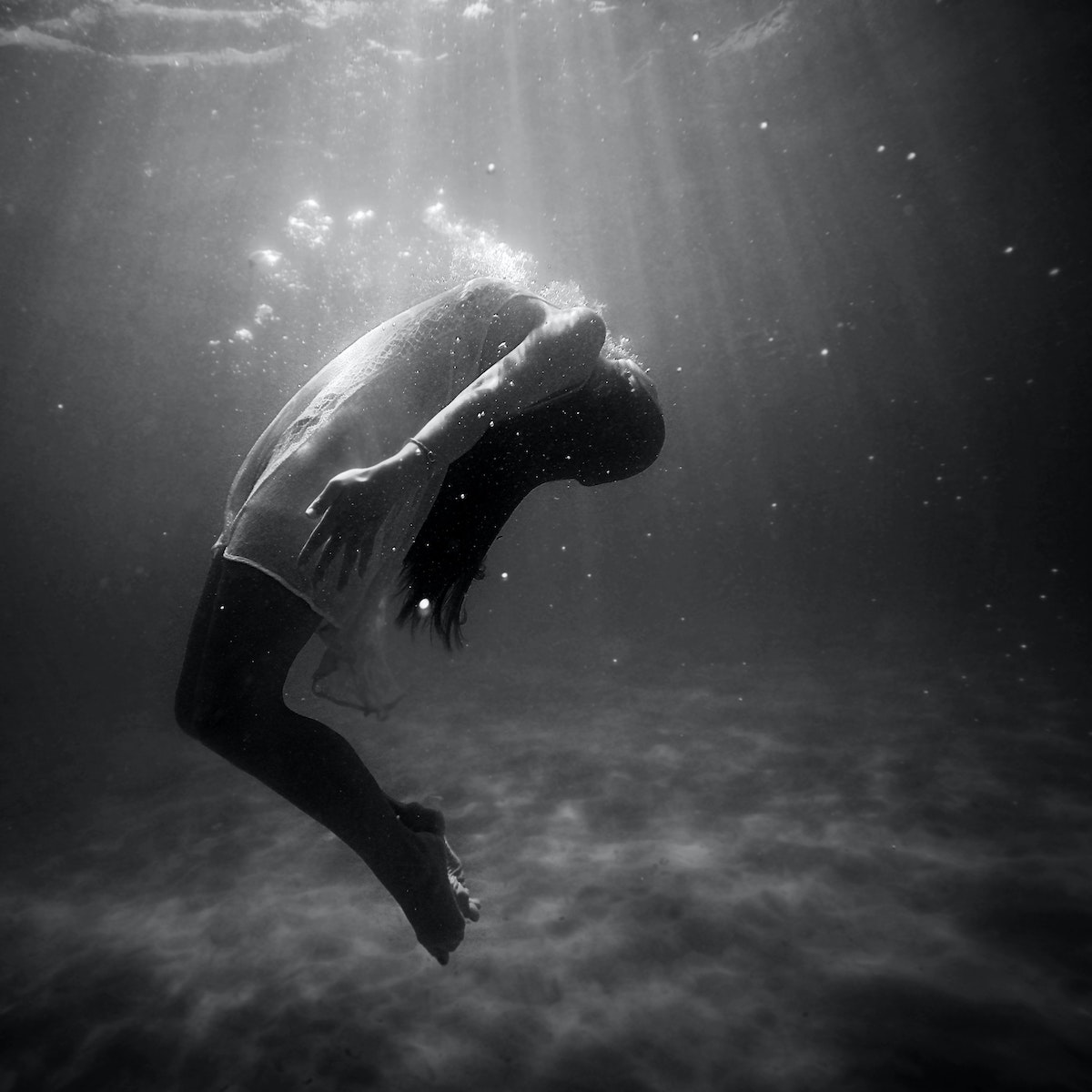
Transcript from a meeting with Jim Eaton on 9 July, 2020
Q: Any time there is the coming of bliss, or joy, it’s mixed with fear and holding. Like when you were doing the meditation at the beginning; there’s a part of me that wants to join you, but every time I get near the edge of letting go, there’s such a holding within me of, “It’s scary. It’s scary there!” Even though I know it’s absolutely divine, it’s absolutely terrifying at the same time! So I’m stuck in this duality: one part of me is longing for this sensation, and the other part is holding back saying, “No, there’s danger there!” Why am I holding on when the release is so beautiful; why?
Jim: When the separate-self-identity first forms, it’s only a fledgling self; it’s very fragile, and could easily collapse and disintegrate. At this point, if it were to disintegrate, then we’d regress back to the unconscious wholeness we experience when we’re born—when we have no self-awareness.
So, initially, it’s very important that we resist that disintegration—so that the separate self can become well established. It’s not a mistake the separate self! We need to really appreciate that, and bow down to it and say, “Thank you!” Because without that developmental stage, and the self-awareness it gives rise to, we would never be having this conversation right now; we’d be unable to adapt to living in the world, to think conceptually, to reflect—we would effectively remain as infants, and unable to survive independently. So initially there’s a very real fear of losing that structure.
However, once we have adapted to our surroundings, and developed a healthy autonomy, the separate-self-identity has served it’s purpose and is no longer required. Then a new developmental stage is possible: to allow the separate-self-identification to fall away, and rediscover our true identity as the wholeness of being. But this time it’s a progression, not a regression—since we rediscover wholeness consciously, rather than unconsciously as before.
So that’s why there’s such a fear: because at one point we had to really resist the disintegration of the separate self—in order to develop self-awareness and adapt to modern living. But now we’re taking the next developmental step, and the invitation is to meet that old fear. So, not trying to get rid of it, and not trying to bulldoze through it, but meeting it and honouring it, “Thank you for enabling self-awareness to emerge. You did that! Thank you.” But now there’s is this new possibility.
(silent connecting)
See what’s there now . . . See if you can meet that edge right now . . . Just check in.
Q: There’s excitement; my heart’s more open . . . The fear element is releasing a bit, and there’s more of the excitement of what it is, rather than the clinging. So there’s some joy.
Jim: Yeah, stay with that. Let that natural joy, that excitement deepen, so that the sense of an edge or boundary starts to soften and open, and you allow yourself to let go deeper into that, and deeper into that, letting go . . . deeper in. Letting the sounds, the sensations, the smells fill up this openness that you are . . . Letting the breath deepen and open, and the body open wider . . . Keep listening . . .
(silent connecting)
See what comes as I ask you these questions: are you allowed to be, to open, to be all that you are? Are you allowed?
Q: [starts to cry] No!
Jim: Just let that voice and those feelings come, “I’m not allowed.” Stay with that . . . Why are you not allowed? See what comes, intuitively.
Q: I haven’t got words right now.
Jim: Just stay with the sense of it. Just be with it, allowing it to be there . . . You, this open presence, holding the one that’s not allowed . . .
(silent connecting)
There’s the pain of not being allowed, of being left out . . . [Q crying] That’s it, just connecting with that . . . Just wants so much to be included, to be loved, to be here, to feel expressed; but not allowed, shut out . . . lonely and afraid . . . Stay with it, stay with it.
(silent connecting)
Q: [Starts to laugh] That feels better!
Jim: Beautiful. You stayed with it, and you allowed it to be there, and this is the magic: we can open and allow whatever is there to be fully experienced, to fully emerge, be honoured, one hundred percent. That’s the magic, because in feeling that honouring, that unconditional inclusion, the contraction naturally opens. Nobody has to do anything. You don’t force it open. It’s just like when you have a conversation with someone: if you feel included, if you feel the other person is really listening to you, then the conversation goes well and you naturally open up, and it deepens and enriches.
Q: [Standing up] I feel so much lighter. [Q laughing]
Jim: So, really feeling that lightness . . . feeling it in the body. [Q laughing] Playing with it . . . delicious, sweet . . . “Thank you, thank you. Bring me more!”
Q: Thank you, thank you. Thank you Jim.
Jim: Ah, thank you.
We all grow up in this ‘domination culture’, so we’ve learnt to make demands of each other, to judge, blame and criticise each other, to try to control and manipulate each other; and at the same time we suppress our supposed ‘weaknesses’ and deny responsibility for our actions. Now we’re learning a new language: the language of loving inclusion, that’s unconditional—’just as you are’—and, ah, it’s pure magic! Or maybe sorcery would be a better term, because it’s coming from source; source-ery!
.[Q moving body]
We all have inside us this terrified little one, who is terrified of life really, which has the effect of constraining and distorting our actions; until we’re able to do exactly what you’re doing now, and turn around and meet that part of ourself, soothe that part of ourself, until the dissociation breaks down and it integrates back into wholeness.
Q: Jim, do you have any advice for when that patterning occurs—where I feel the small-self coming in, and the closing, and the fear—about how to come out of the pattern?
Jim: Feel your feet on the floor, sitting bones on the chair, notice your breathing, feel the tingling sensations in your fingers, and try and accommodate the pattern as it arises. Immediately that you’re accommodating it, then you’re not it; you’re this loving holding that you just experienced then, that’s not trying to get rid of it, but that’s allowing it to be there, just as it is. If that’s possible then that’s amazing, but sometimes you won’t to be able to do that; then it can be helpful to find some space away from the situation—going to the toilet is always a good option!
Q: Yeah!
Jim: Maybe then you can find the space, away from others, to meet what’s coming up; but sometimes it will be impossible, and you’ll just be lost in it. And when you come to realise you’ve been lost in it, the most important thing then is to be gentle with yourself; otherwise you can easily get lost again in that secondary pattern of beating yourself up for having got lost inside the pattern! That’s just not helpful. So, we gift ourselves that same kindness that we would gift to others, “Oh, yeah I got lost. Thank you for the fact that I’m now realising that I was lost!”
Q: Do you think it’s valid to fear that unknown; because you said, coming into the world we build up these identities, and the safety mechanism of, “It’s dangerous”?
Jim: Yeah, because if we’re not able to establish that separate-self-identity, then we’re not able to develop the healthy autonomy we need to survive and thrive in the world—that’s why we fear the disintegration of the separate self. From another perspective, if we don’t have that healthy autonomy, then when life becomes overwhelming, in order to escape we may try to deliberately disintegrate our ‘unhappy self’—through alcoholism, drug abuse, or suicide; but that’s a regressive step, in that it take us back to unconscious wholeness. What we’re talking about is a progressive step, towards conscious wholeness.
You can see these stages playing out either on an individual level, or on a collective level. At one point in our human story, we didn’t have self-awareness. We were purely instinctive creatures, embedded within the matrix of nature. So we were savage and murderous, but innocently so, since we had no reflective capacity and so were entirely possessed by our instincts. This was like our ‘early childhood’.
Then, supposedly around two hundred thousand years ago, this ability to self-reflect began to emerge, that enabled us to ‘wake up’ from being controlled by our instinctual nature, and start to think abstractly—to imagine and create. Since then the journey has been about establishing and consolidating that self-aware, separate-self-identity. This has been our ‘adolescence’.
Now the invitation is to transcend our separate-self-identity and rediscover wholeness consciously. This is our ‘adulthood’.
So yes, there’s that original fear, of being devoured by the unconscious and losing self-awareness; and there can also be original guilt and shame too—from the rationalisation that we must have done something wrong in separating off from wholeness, and the suffering we experience is our just punishment. These feelings are deeply buried in us, deep, deep down—often felt as contractions in the belly, solar plexus and throat—and are the root cause of all our restlessness and longing.
So again, the invitation now is to first discover who we really are, the true ground, our true being, and then, with that divine support, begin to meet that original fear of disintegration, that original guilt and shame of separation—to really feel it, in all its fullness—to lovingly include it, and so allow the separate-self-identification to naturally dissolve.
(silent connecting)
Q: When I expand out of the body in conscious awareness, like this now, with eyes open, and I feel that ‘death’ take place, and the mind goes clear and a bliss emerges, and I get bigger and bigger and bigger, there is a desire for it to continue, and yet there is an absolute fear in my belly of, “What is happening here? This is crazy!” Do you know what that is?
Jim: What’s holding on is where you still have your identity. So we do what we always do: from this place of presence, of wordless knowing, we listen to the belly, allowing the fear to come, the guilt and shame to come. And if it feels too much, and the resistance says, “No more!’ And it shuts down, then that’s ok. There’s no ‘you’ forcing it one way or the other; that would only be another separate-self-fragment to include!
And you said, “I expand out of the body, and I feel myself getting bigger and bigger.” It might feel like that, but it’s good to keep turning it around. You’re not expanding; the previous contraction is relaxing. It’s good to see it that way around, because then you’re not trying to attain anything, you’re not trying to get anywhere. All you’re doing is letting go of a previous contraction and rediscovering what you always, already are.
Q: Yeah, perfect. It’s so true.
Jim: So, when the resistance kicks in and pulls you back, it’s just, “Okay, thank you. I see that that was too much.” You’re not trying to push it. And the confidence grows naturally to let it go further and further.
Q: And will we always have the ability to use the mind and to communicate from that space? Because I think that’s another one of my fears, is that it feels like, “How to do that?”
Jim: Yeah. You’re already doing it! The idea that there’s a separate you-entity inside your body that’s deciding what words to speak, and then is moving the mouth to speak them—that’s an illusion. So nothing will be lost, other than the belief in an illusion.
Q: [Laughing] Yeah!
Jim: What you really are is being the whole show, including the belief that you’re not being the whole show but are just a separate entity inside a body—it’s being that too.
It’s a bit like watching a film, and you’re so avidly watching it, you’re so focused into the movie, that you think you’re the main character, speaking the lines, with all these different things happening to you; and then the spell is broken and, for this analogy to work, you realise you’re the screen—the self-aware screen that’s being the entire movie. And is anything lost in that realisation? No! The movie continues to play out. There’s just that shift in perception.
Q: And how would you keep a safe boundary from that space?
Jim: It’s the same question that you just asked. There is no separate you-entity inside the body doing ‘keeping safe boundaries’ anyway, so nothing is lost. You can still keep safe boundaries, you can still speak like I’m speaking now—words are coming, thoughts are being expressed. It can be a bit disorienting as you see just how invested you were in being ‘the doer’, ‘the speaker’, ‘the thinker’, ‘the taster’, ‘the hearer’, ‘the seer’ in the head, or ‘the one who processes things’, but you’re not going to go mad or collapse in a heap on the floor with dribble running out of your mouth!
The problem is we all hear these big stories don’t we, of people who’ve had these massive awakening experiences and then lose the capacity to function in life, and it scares us. But these stories are so rare. For most people, the identification with these ‘self-fragments’ drops away slowly, rather than all in one go, and so there’s a slow shift in your centre of gravity—from believing you’re an entity in the head, to realizing you’re this beingness, that’s present-ing itself as all and everything. And it’s nice that it’s a slow shift, because then you’re continually reorientating all the way along, so you don’t get these big wipeout experiences where you can’t function for years.
(silent connecting)
Q: Another experience is this one of going out through the heart, which, although again is amazing, is petrifying, and there’s a part of me that goes, “I can’t let go and surrender into that. I’m afraid of it.” But that’s coming from the same place: it’s all holding.
Jim: Yeah. Bow to that little one. “Thank you, thank you for saving me, and enabling this growth to happen. And now there’s is a new possibility, so you can rest. You’ve been frightened and tense and alone for so long, you can come home now and take rest.” That’s the message.
Q: Wow, I really hear it. Thank you Jim for voicing that. Thank you.
Jim: Thank you.



